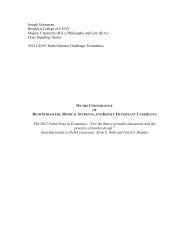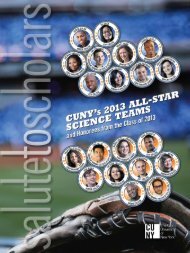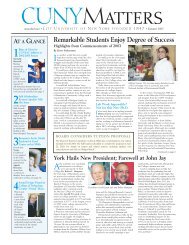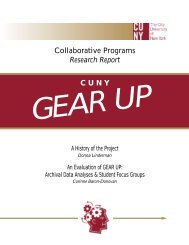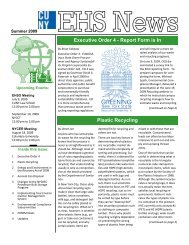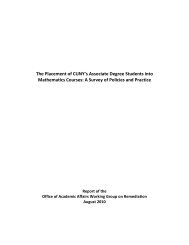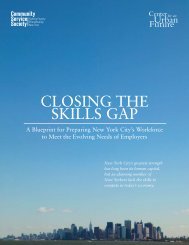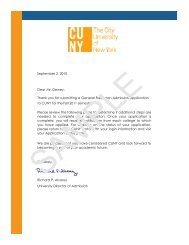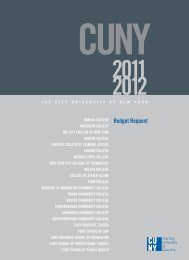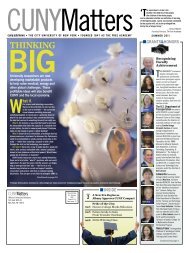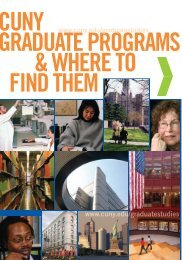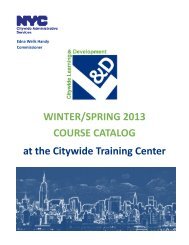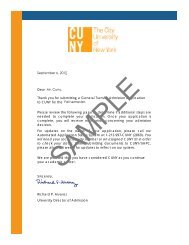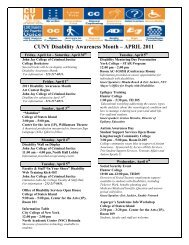CUNY Master Plan 2012-2016
CUNY Master Plan 2012-2016
CUNY Master Plan 2012-2016
You also want an ePaper? Increase the reach of your titles
YUMPU automatically turns print PDFs into web optimized ePapers that Google loves.
THE <strong>CUNY</strong> MASTER PLAN <strong>2012</strong>-<strong>2016</strong><br />
individuals, businesses, the economy and taxpayers. Increasing the number of community college students<br />
who graduate will not only make it easier for employers to find qualified workers, it will dramatically<br />
raise the employment prospects of graduates and put them on a career track with significantly<br />
higher earning potential. And, of course, with higher earnings comes more spending in the local economy,<br />
higher tax receipts and more effective public investments in the form of operating aid and grants.” 8<br />
Each of the community colleges of <strong>CUNY</strong> has developed programs on its campus that have shown positive<br />
results in improving retention and graduation rates. From the development of learning communities<br />
at Kingsborough, to the establishment of curricular academies at Queensborough, to the use of<br />
e-portfolios at La Guardia, faculty and staff are consistently assessing their work to ensure that students<br />
are achieving greater levels of success. Many of these interventions have been part of large nationwide<br />
efforts to impact student success and have been rigorously evaluated by organizations such as MDRC and<br />
the Community College Research Center of Columbia University. Major foundations including Gates,<br />
Robin Hood, Helmsley, Hecksher, Walmart and others have reinforced the good work of <strong>CUNY</strong>’s community<br />
colleges with large grants that invest in the best practices that have been implemented on <strong>CUNY</strong><br />
campuses. Over the next four years, <strong>CUNY</strong> will continue to play an active role on the local and national<br />
stage, sharing with colleagues those practices that have proven successful, as well as continuing to support<br />
faculty and staff innovation to improve graduation rates. In September 2011, <strong>CUNY</strong> hosted “Reimagining<br />
Community Colleges: A National Colloquium.” Educators from 26 states and the District of<br />
Columbia gathered to examine the mission, structures, and practices of community colleges. In opening<br />
remarks Chancellor Goldstein said, “If we don’t reimagine community college education, and convince<br />
the marketplace of its tremendous value to our future, our country’s entrepreneurial capacity and its<br />
educated workforce—that is, our social and economic front line—will be seriously compromised.” Two<br />
<strong>CUNY</strong> initiatives, described below, are leading the way in rethinking community college education in<br />
support of significantly increased student success.<br />
Accelerated Study in Associate Programs (ASAP)<br />
ASAP has proven to be one of the most successful community college programs in <strong>CUNY</strong>’s—as well as<br />
the country’s—history. Created in fall 2007 with funding from the Mayor’s Center for Economic Opportunity<br />
(CEO), the program is designed to help students earn their associate degrees as quickly as possible,<br />
with a goal of graduating at least 50 percent within three years. The fall 2007 cohort exceeded the goal<br />
and achieved a 55 percent three-year graduation rate versus 24 percent for a comparison group. The<br />
ASAP graduation rate was three times the national urban community college three-year rate of 16 percent.<br />
The fall 2009 cohort, primarily low-income students with developmental education needs in one or<br />
two courses, realized a two-year graduation rate of 28 percent versus 7 percent for a comparison group,<br />
and will likely meet the 50 percent target by next summer after three years in the program.<br />
8<br />
Center for an Urban Future. Mobility Makers. November 2011<br />
52



